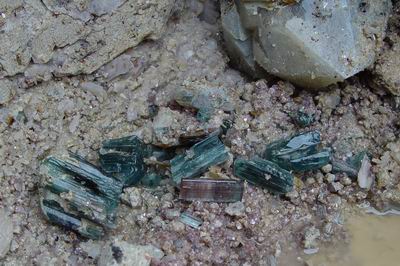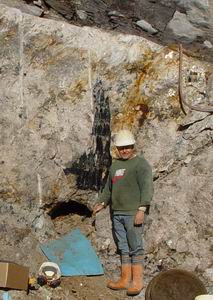Oxford County, Maine
Coromoto Minerals
The 2004 Season at Mt. Mica
---- October Page 2 -----

Blue and Pink elbaite on lepidolite
grains in pocket MMP25-04
Coromoto Minerals
The 2004 Season at Mt. Mica
---- October Page 2 -----

Blue and Pink elbaite on lepidolite
grains in pocket MMP25-04
| The zone enriched in cesium and lithium provided an
interesting diversion but failed to produce a significant cavity. There
were vugs filled with clays that produced the occasional shard of
bright pink elbaite or a quartz crystal or two. The area
immediately surrounding the pollucite was especially rich in white
montmorillonite with embedded small pink elbaites. We worked this area
down dip until we were again faced with the task of overburden removal.
At this point, we turned our attention to the up strike working
face. To work this face we had only to remove 10-15 or so feet of
the schist that remained after our first 15 foot bench As we began to work the up strike face, we were forced into blasting the upper 8-10 feet of the pegmatite before we could then attempt to mine the mineralized zone. This was somewhat of a novelty. Unfortunately, the upper layer was decidedly barren. In addition it seems that as the pegmatite thickened, rather than there occurring more mineralization of interest, what there was seemed to become diffused through this larger volume. As mentioned, the mineralized zone or garnet line seemed oblivious to this thickening as well. It proceeded unimpressed along its steady 20 or so degree dip into the ground. The extent of its progress is revealed in the two images below. Approximately 100 years separates the two images. The photographers, however, must have been standing in nearly the same place as the background view is nearly identical . The summit of Crooker mountain is visible in both. Only the depth of the overburden to reach the pegmatite has changed and of course the ancillary equipment. In the image at the left one can see the hoist driven by real horsepower used to remove muck from the pit.
As we drilled each pattern of holes across this 30 foot face, we watched the dust coming up intently. If we drilled lots of schorl our prospects  would
be more
promising in the pocket department. We had not actually drilled into a
pocket for quite some time. In fact, except for a couple of glancing
blows, we had not seen the drill drop into a sizable cavity since
pocket MMP11-04 ( pocket 11). We had found 13 pockets in the interim
though. Hence, I took careful note as black dust started
appearing just 1 foot or so into the ledge as I drilled my end of the
bench on October 20 while Richard worked his end. Through two steel
changes, the dust continued to pour up black. would
be more
promising in the pocket department. We had not actually drilled into a
pocket for quite some time. In fact, except for a couple of glancing
blows, we had not seen the drill drop into a sizable cavity since
pocket MMP11-04 ( pocket 11). We had found 13 pockets in the interim
though. Hence, I took careful note as black dust started
appearing just 1 foot or so into the ledge as I drilled my end of the
bench on October 20 while Richard worked his end. Through two steel
changes, the dust continued to pour up black. When drilling
a
hole, there isn't much to do other than watch for the steel to break or
jam, with subsequent negative consequences, and think about what will
soon be exposed by the blast. So in this day dreaming mode watching
more black dust come up, I thought to myself, 'If this had been on the
pocket 11 end of the pegmatite, the drill would be dropping into a
pocket'. No sooner than this thought had been vibrated from deep in my
brain, then drill let go dropping into a space and drenching me with
cold water. I had been sitting on the drill, so dismounting was not
instantaneous but the cold water did provide plenty of incentive.
I stopped the drill and called Richard over. It is always interesting
at this stage to see what percolates up out of the hole with a few
blasts of air from the hammer. In this case
there was copious water, so we knew the hole was not tiny. Our next
move required us to drill holes to the side of the one I had just
drilled and in front in
order to open the pocket with minimal damage. The first drill hole, of
course,
would not be loaded. In the image, Richard stands by the
freshly opened pocket. This pocket was classical Mt Mica, in that the
schorl grew above and into the pocket. Notice the two fractures that
lead to the pocket. One is rusty and the second one goes behind Richard
and up towards the air line. Larger pocket seem to be sitting within a
web of such cracks. This pocket was filled with loose grains of
lepidolite which has proven to be a promising pocket sign. A little
digging showed that this pocket, perhaps the size of two bushel
baskets,
contained blue and pink elbaite. The schorl in the image had
grown into the back of the pocket. Its terminal end had first gone to
pastel pink than pale blue. The image of the assembled doubly
terminated crystal shows interesting color zoning. It starts blue at
the top, grades to blue with a reddish interior, then to red, and
finally
red with a blue core.
When drilling
a
hole, there isn't much to do other than watch for the steel to break or
jam, with subsequent negative consequences, and think about what will
soon be exposed by the blast. So in this day dreaming mode watching
more black dust come up, I thought to myself, 'If this had been on the
pocket 11 end of the pegmatite, the drill would be dropping into a
pocket'. No sooner than this thought had been vibrated from deep in my
brain, then drill let go dropping into a space and drenching me with
cold water. I had been sitting on the drill, so dismounting was not
instantaneous but the cold water did provide plenty of incentive.
I stopped the drill and called Richard over. It is always interesting
at this stage to see what percolates up out of the hole with a few
blasts of air from the hammer. In this case
there was copious water, so we knew the hole was not tiny. Our next
move required us to drill holes to the side of the one I had just
drilled and in front in
order to open the pocket with minimal damage. The first drill hole, of
course,
would not be loaded. In the image, Richard stands by the
freshly opened pocket. This pocket was classical Mt Mica, in that the
schorl grew above and into the pocket. Notice the two fractures that
lead to the pocket. One is rusty and the second one goes behind Richard
and up towards the air line. Larger pocket seem to be sitting within a
web of such cracks. This pocket was filled with loose grains of
lepidolite which has proven to be a promising pocket sign. A little
digging showed that this pocket, perhaps the size of two bushel
baskets,
contained blue and pink elbaite. The schorl in the image had
grown into the back of the pocket. Its terminal end had first gone to
pastel pink than pale blue. The image of the assembled doubly
terminated crystal shows interesting color zoning. It starts blue at
the top, grades to blue with a reddish interior, then to red, and
finally
red with a blue core.
Since our benches were quite high above the quarry floor and significantly sloped, the onset of frost would render these areas too unsafe to work. If we were going to stretch our mining season, we would have to adopt a new strategy and do it very soon.
|
||||||